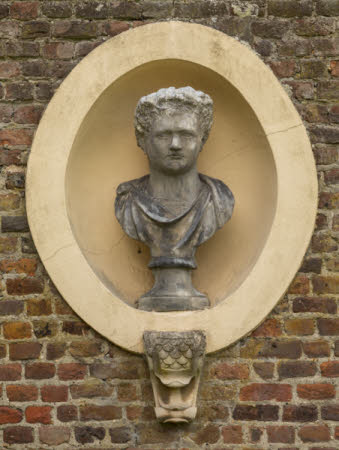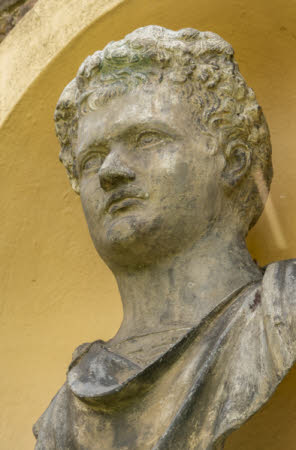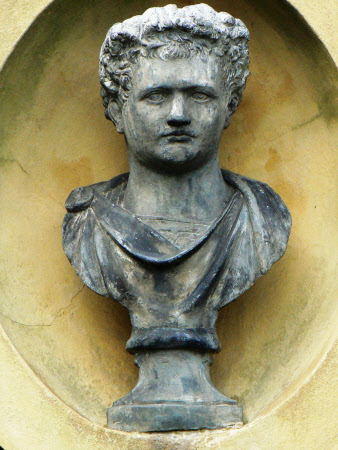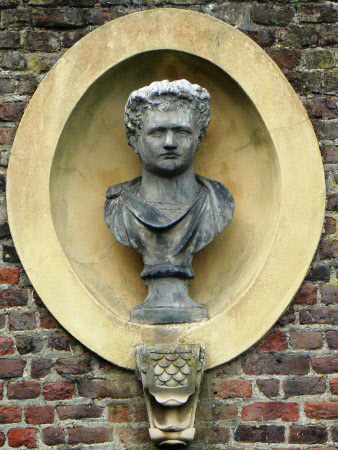Bust of a Roman emperor, perhaps Domitian
workshop of John Besnier (fl.1681)
Category
Art / Sculpture
Date
c. 1670 - 1672
Materials
Lead, Sandstone
Measurements
765 mm (H)435 mm (W)
Place of origin
London
Order this imageCollection
Ham House, Surrey
NT 1140363
Summary
A lead portrait bust of a Roman emperor, perhaps Domitian, wearing armour, with a corselet over which is a cloak, and with an oak wreath in his hair. One of thirty-eight lead busts made for the garden walls of Ham House in 1671-72, perhaps in the workshop of John Besnier, thirty-six of which survive in niches on the walls and on the north façade of the house.
Full description
A lead portrait bust of a Roman emperor, wearing armour, with a square-necked corselet, over which is a cloak, fastened at the right shoulder with a round brooch. He has an oak-leaf wreath in his curly hair, and looks straight ahead. Mounted on a plinth, and placed on a sandstone console carved with a scale pattern and below overlapping tongues. The youthful emperor in this portrait wears a wreath of oak leaves known as the corona, that was the second most important civic order in Rome. To be awarded the crown, the recipient had to have preserved the life of a Roman citizen in battle, to have slain his opponent and, finally, to have held the ground on which the action took place. A number of the Roman emperors assumed to themselves the honour, so its presence cannot be used to identify the subject of the bust. However, the strong profile and firm, sharply-pointed nose might suggest that it represents the emperor Domitian (A.D. 51-96, reigned 81-96). It is one of two busts of the same model at Ham (the other is NT 1140340) and would have originally formed part of a sequence of the Twelve Caesars. One of thirty-six lead busts displayed in oval niches in the garden walls and on the north façade of Ham House, probably installed in 1671-72, and recorded in the 1679 inventory of Ham House. The entire series was probably arranged in its present positions along the garden walls and on the north front of Ham House by the 6th Earl of Dysart, as part of improvements undertaken between 1798 and 1803. The busts may well, like other sculpture at Ham House, have been made in the workshops of the Besnier family, perhaps by John Besnier, who received a commission for lead statuary from the Duke of Ormonde in 1681. For a fuller discussion of the garden wall busts and their history and attribution, see NT 1140333. Jeremy Warren January 2022
Provenance
Probably made and installed in 1671-72, to the commission of John Maitland and Elizabeth Murray, 1st Duke and Duchess of Lauderdale. Thence by descent,until acquired in 1948 by HM Government when Sir Lyonel, 4th Bt (1854 – 1952) and Sir Cecil Tollemache, 5th Bt (1886 – 1969) presented Ham House to the National Trust. Entrusted to the care of the Victoria & Albert Museum until 1990, when returned to the care of the National Trust, to which ownership was transferred in 2002.
Makers and roles
workshop of John Besnier (fl.1681), sculptor
References
Avery 2013: Charles Avery, ‘Seventeenth-century Sculpture at Ham House’ in Christopher Rowell, ed., Ham House. 400 Years of History, New Haven/London 2013, pp. 158-77., pp. 172-76



